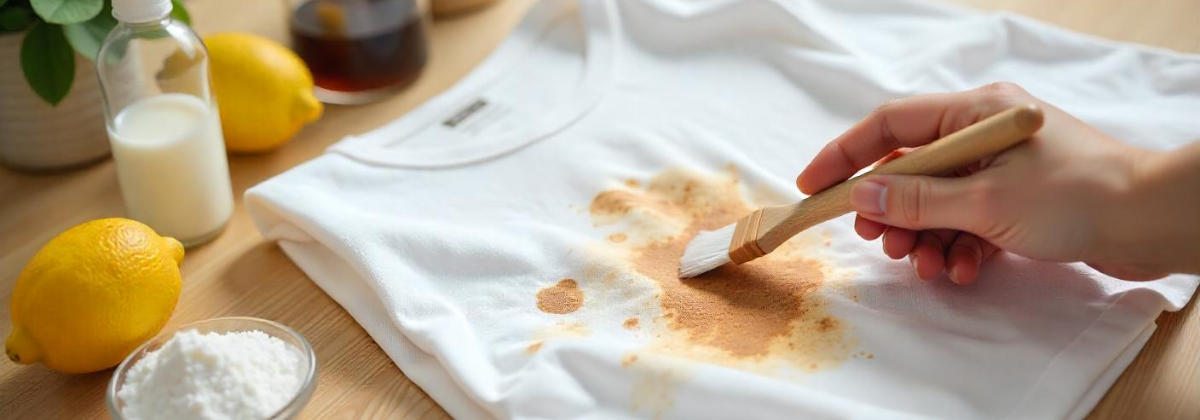27 Mar How to Remove Stains from Clothes After They Have Already Set In
Nothing is more frustrating than discovering an old stain on your favourite shirt. Once a stain sets in, it becomes tougher to remove, but that doesn’t mean your clothes are ruined. With the right techniques and a little patience, you can remove set-in stains and restore your garments to their original condition. Whether it’s coffee, grease, or ink, this guide will help you tackle stubborn stains and keep your wardrobe looking fresh.
Why Are Set-In Stains Harder to Remove?
Set-in stains are more difficult to remove because they have had time to bond with the fabric fibres. When a stain is fresh, it sits on the surface of the fabric, making it easier to lift. However, once it dries, it becomes embedded, requiring stronger treatments to break it down.
Several factors make set-in stains stubborn:
-
Absorption into fibres: Fabrics, especially natural ones like cotton and wool, absorb liquids over time, making stains penetrate deeper.
-
Heat exposure: If a stained garment goes through the dryer before the stain is removed, the heat sets the stain further, making it almost permanent.
-
Oxidation: Some stains, such as wine, coffee, and sweat, oxidise when exposed to air, causing them to darken and become tougher to lift.
-
Chemical bonding: Certain stains, like grease or ink, contain compounds that chemically bond with fabric fibres, requiring specific solvents to break them down.
Because of these factors, removing set-in stains requires extra steps, such as soaking, pre-treating with stain removers, and using stronger cleaning solutions. However, with the right approach, even the toughest stains can be eliminated.
Step-by-Step Guide to Remove Set-In Stains
1. Identify the Stain Type
Before choosing a stain removal method, determine what caused the stain. Common culprits include:
- Grease and oil: Butter, salad dressing, motor oil
- Protein-based stains: Blood, sweat, dairy products
- Tannin stains: Coffee, tea, red wine
- Dye stains: Ink, berries, food colouring
Knowing the stain type helps you select the best cleaning solution.
2. Soak the Fabric
Soaking helps loosen the stain before washing. Use these methods depending on the stain:
- Grease stains: Soak in warm water with washing-up liquid
- Protein stains: Use cold water, as hot water can set the stain further
- Tannin stains: Mix warm water with white vinegar for better results
Let the fabric soak for at least 30 minutes or overnight for tougher stains.
3. Apply a Stain Remover
Choose a stain remover that suits the stain type. Some effective options include:
- Baking soda paste: Mix baking soda with water and rub it into the stain
- White vinegar and dish soap: Combine equal parts and apply to the fabric
- Hydrogen peroxide (for whites): Works well on old blood and sweat stains
Gently scrub the stain with a soft brush or an old toothbrush to help the solution penetrate the fibres.
4. Wash the Clothes Properly
After pre-treating, wash the garment in the hottest water safe for the fabric. Check the care label to avoid damage. Adding oxygen bleach (not chlorine bleach) can further boost stain removal.
5. Check Before Drying
Before putting clothes in the dryer, inspect the stain. If any residue remains, repeat the process. Drying can permanently set a stain if it hasn’t been fully removed.
Additional Tips to Remove Set-In Stains
If a stain has already set in, don’t lose hope! With the right techniques, you can still lift stubborn marks and restore your clothes. Here are some extra tips to remove set-in stains effectively:
- Use Enzyme Cleaners for Protein-Based Stains: For stains like blood, sweat, dairy, and baby formula, enzyme-based detergents work wonders. These break down the proteins in the stain, making them easier to remove. Apply the detergent directly, let it sit for 15–30 minutes, then wash as usual.
- Try Rubbing Alcohol for Ink and Dye Stains: Ink and dye-based stains, such as marker or hair dye, respond well to rubbing alcohol. Dab alcohol onto a cotton pad and blot the stain—don’t rub, as this can spread it. Rinse and repeat until the stain fades.
- Use Baking Soda for Grease and Oil Stains: Oil stains can be tricky, but baking soda absorbs grease effectively. Sprinkle baking soda on the stain, let it sit for at least an hour (or overnight for tougher stains), then brush it off before washing.
- Apply White Vinegar and Dish Soap for Tannin Stains: For tea, coffee, and red wine stains, mix equal parts white vinegar and dish soap. Apply the solution, let it sit for 10–15 minutes, then blot and rinse before washing.
- Try Hydrogen Peroxide for Sweat and Deodorant Stains: Hydrogen peroxide is a great option for white clothes with stubborn yellow stains. Pour it directly onto the stain, let it bubble, then scrub lightly before washing.
- Lemon Juice and Sunlight for Natural Whitening: If you’re dealing with set-in stains on white fabrics, apply fresh lemon juice to the stain and place the garment in direct sunlight. The natural bleaching effect of the sun can help lift the stain.
- Use Oxygen Bleach for Extra Tough Stains: For persistent stains, add oxygen bleach (not chlorine bleach) to your wash. It’s safe for most fabrics and helps break down stubborn marks without damaging fibres.
- Always Check Before Drying: Never put stained clothes in the dryer unless you’re sure the stain is gone. Heat can permanently set a stain, making it almost impossible to remove. If the stain remains, repeat the treatment before drying.
By following these extra steps, you can remove set-in stains and keep your clothes looking fresh. Patience and the right techniques make all the difference!
Prevent Future Stains from Setting
- Treat stains immediately to prevent them from drying
- Use a laundry pre-treatment spray before washing
- Always check for stains before putting clothes in the dryer
By following these methods, you can remove set-in stains and keep your clothes looking fresh. Don’t give up on a stained garment—use the right approach, and you can restore it to its former glory!




Sorry, the comment form is closed at this time.